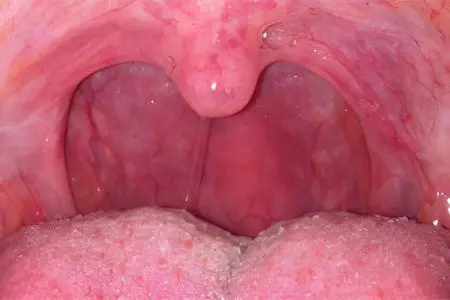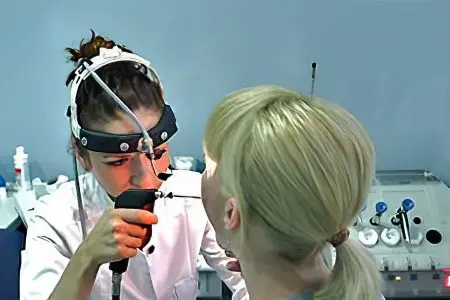Contents
Chronic pharyngitis – This is an inflammatory process that occurs in the mucous membrane of the pharynx. Chronic pharyngitis is the result of inadequate treatment of acute inflammation, or the result of the negative impact of a number of other pathogenic factors.
Chronic pharyngitis is usually divided into catarrhal, hypertrophic (granular and lateral) and atrophic pharyngitis.
Causes of chronic pharyngitis

The causes of chronic pharyngitis are varied, but prolonged irritation of the pharyngeal mucosa is almost always present.
Among the etiological factors leading to chronic inflammation, there are:
Acute recurrent inflammation of the pharynx, tonsils, nose and paranasal sinuses caused by viruses or bacteria. This includes rhinitis, sinusitis, tonsillitis. In addition to the fact that there is a source of inflammation in the upper respiratory tract, vasoconstrictor drops used to reduce catarrhal phenomena have an additional irritating effect on the back of the pharynx.
Prolonged violation of nasal breathing, contributing to the drying of the pharyngeal mucosa.
Hypothermia, both local and body as a whole.
Smoking.
Unfavorable ecological situation in the area of residence (gas pollution, high concentration of harmful emissions, smoke, etc.).
Occupational hazards are dry and hot air, a high concentration of cement and clay in the inhaled air (porcelain industry), flour (flour milling), etc.
Constitutional features of the structure of the upper respiratory tract, contributing to the development of inflammatory processes in them.
Hemodynamic disturbances in the upper respiratory tract caused by diseases of the cardiovascular system.
Diseases of the digestive tract, in which there is a constant reflux of the acidic contents of the stomach into the esophagus, which provides irritation of the pharyngeal mucosa. These can be diseases such as reflux esophagitis, gastritis, hiatal hernia, etc.
Hormonal and endocrine disorders.
Dental caries. Stomatitis and gingivitis can also provoke the development of inflammation.
Failure of the immune system.
Allergic diseases.
Abuse of alcoholic beverages.
Predominance in the diet of spicy, very hot or very cold food.
Chronic infections such as tuberculosis.
Injuries received during surgery or when a foreign body enters the pharyngeal cavity.
Symptoms of chronic pharyngitis
Symptoms of chronic pharyngitis are reduced to perspiration, soreness, tickling and other uncomfortable sensations in the throat, which are aggravated during swallowing. The form of the disease will have an impact on the clinical picture of pharyngitis, somewhat modifying the manifestations of inflammation.
Symptoms of catarrhal chronic pharyngitis
In the catarrhal form of the disease, diffuse venous hyperemia is detected, the mucous membrane becomes pasty, as small veins expand and blood stagnates in them. As a rule, all parts of the pharynx are exposed to inflammation, often the auditory tubes, the excretory ducts of the paranasal sinuses are often involved in the pathological process.
Among the complaints that patients present:
Feeling of itching and rawness in the throat, which is worse when swallowing.
Sensation of a foreign body in the throat, which is not an obstacle to the passage of food and liquids. But at the same time, such a feeling of discomfort makes the patient swallow more often.
Thick mucous sputum accumulates in the pharynx, which makes a person cough all the time. Cough becomes more pronounced in the morning. During exacerbations of chronic catarrhal pharyngitis, coughing may be accompanied by nausea and even vomiting.
The mucous membrane of the throat, uvula and soft palate are thickened. On the pharynx, areas covered with mucus or mucopurulent secretion are visible. Some groups of follicles are enlarged in size.
Symptoms of hypertrophic pharyngitis
As for the hypertrophic form of the disease, then with it all layers of the mucous membrane of the pharynx thicken, it itself becomes denser and thicker. Lymphatic and blood vessels dilate. Most often, the hypertrophic process proceeds according to the type of granular pharyngitis, when the mucous membrane of the posterior pharyngeal wall is affected. In some cases, the lateral walls of the pharynx (lateral hypertrophic pharyngitis) are involved in the pathological process. In this case, the follicles are combined with the infected lymphoid folds of the pharynx, which creates the impression of the presence of additional posterior arches.
As for the complaints made by patients, they are as follows:
Violent scratching in the throat, resembling scratching.
Pronounced sensation of the presence of a foreign body in the throat.
Frequent swallowing of saliva with which a person tries to get rid of an obstruction.
Mucopurulent secretions flowing down the back of the pharynx become very viscous, form crusts, which are separated with great difficulty.
A strong cough is also observed due to the fact that crusts of dried mucus irritate the nerve endings of the laryngeal nerve.
The patient’s voice is often hoarse.
Symptoms of atrophic pharyngitis
The mucous membrane of the pharynx in the atrophic form of the disease is very thin and excessively dry. If the disease is acute, then the pharynx looks shiny, varnished. The size of the mucous glands is reduced, the epithelial cover of the pharynx exfoliates with small scales.
Among the complaints that patients present:
Great dryness in the throat, which comes to the fore, prevailing over other symptoms.
Difficulty swallowing food and liquids. An empty sip is especially painful.
From the mouth of patients comes an unpleasant odor.
Often during a conversation, a person has a desire to take a sip of water.
It is worth noting that the symptoms, even with minor lesions of the mucous membrane of the throat, can be quite pronounced, and with running processes it can be very scarce.
Diagnosis of chronic pharyngitis

Diagnosis of chronic pharyngitis is built on pharyngoscopy, which is carried out in the office of an otolaryngologist.
The criteria for assessing the condition of the pharyngeal mucosa, which allow making a diagnosis, are as follows:
The catarrhal form of the disease is indicated by a slight swelling and thickening of the mucous membrane of the pharynx, the presence of cloudy mucus in some of its areas.
The granulosa form of the disease is indicated by the presence of lymphoid granules, which look like semicircular elevations the size of a grain of millet. These elevations are red. The mucosa of the pharynx itself is also red, the veins penetrating it are visible. With lateral pharyngitis, the lymphoid ridges are thickened and hyperemic.
The atrophic form of the disease is indicated by a thinned dry mucous membrane of a pale pink color. In some places it is covered with crusts and viscous stretching mucus.
To clarify the cause of inflammation, a swab is taken from the pharynx for bacterial and virological examination. It is possible that the patient will need to be examined by a dentist, endocrinologist, gastroenterologist and other specialists.
Treatment of chronic pharyngitis
Treatment of chronic pharyngitis is carried out in an outpatient setting. Its primary goal is to eliminate the local and general causes that provoked the development of the disease. These can be infections of the nasal cavity and paranasal sinuses, tonsils, etc.
It is important to get rid of external irritants such as exposure to tobacco smoke, dusty and polluted air. Food should be sparing, all spicy, spicy, pickled and fried foods should be excluded from the menu. If the patient has chronic diseases of the gastrointestinal tract that support inflammation in the pharyngeal mucosa, then they must be disposed of.
Proper oral hygiene is important. The mucous membrane of the pharynx should be regularly cleansed of crusts and mucus.
Treatment of hypertrophic and catarrhal forms of pharyngitis
For gargling with a hypertrophic form of the disease, a warm isotonic solution of sodium chloride is used. It can also be used for inhalation using a nebulizer.
The mucosal edema can be reduced by applying a solution of Lugoll, Protargol or Collargol to the back wall of the pharynx. Irrigation of the throat with Geksoral, Miramistin, Octenisept is effective. Also for rinsing, you can use an infusion of sage and chamomile, Bicarmint.
The composition of complex therapy can include lozenges with antiseptic and bacteriostatic effect – these are Lizobakt, Faringosept, Geksaliz.
If a patient has large granules on the pharyngeal mucosa, they are removed using cryotherapy, or cauterized with a solution of silver nitrate.
Treatment of atrophic pharyngitis
To get rid of atrophic pharyngitis, it is important to thoroughly and regularly wash off the mucopurulent masses and crusts from the surface of the pharynx. The best remedy for this is a 1% sodium chloride solution, to which 4 drops of 5% iodine should be added. Sodium chloride for such an amount of iodine will require 200 ml. If you regularly irrigate your throat with such a remedy, this will get rid of discomfort in the throat and reduce the symptoms of inflammation.
Periodic lubrication of the posterior pharyngeal wall with Lugol’s solution is also effective. It is important that the compositions used to treat atrophic pharyngitis do not dry out the mucous membrane, as this will lead to suppression of the functioning of its glands. So, the use of sodium bicarbonate (baking soda), eucalyptus and sea buckthorn oil is prohibited.
Novocaine blockades of the posterior pharyngeal wall have proven themselves well. They can be combined with such biological stimulants as Traumeel, Aloe, Vitreous. The course of novocaine blockades consists of 8 procedures, the interval between them should be at least 5 days.
As for antibacterial drugs, they are used in chronic pharyngitis only during the period of exacerbation of the disease, when laboratory use confirms the presence of pathogenic bacterial flora. It is possible to use drugs from the group of penicillins, cephalosporins and macrolides. Systemic administration of antibiotics is mandatory for pharyngitis provoked by beta-hemolytic streptococcus.
A wide choice of antibacterial and antiseptic agents for the treatment of pharyngitis is limited by the spectrum of their antimicrobial activity, the absence of allergic reactions in the patient. Also, the drug should not be toxic.
Prevention of recurrence of chronic pharyngitis is the observance of a healthy lifestyle, the rejection of bad habits, the normalization of nasal breathing, if it has been disturbed. Periodic use of drugs-immunomodulators is possible.









